Envision Math Grade 8 Volume 1 Student Edition Solutions Chapter 1 Real Number Exercise 1.7
Page 45 Exercise 1 Answer
We need to determine whether the relationship shown for Set 1 is also true for Sets 2-5.
In the first set, the number of sit-ups they do is 64
In the next set, it will be 32 since it is half as many for each subsequent set.
For third set,16
The number of sit-ups is represented by the equivalent expression, 27−n
where n is the number of sets.
This expression is used to determine the number of sit-ups they do in each set.
Using this expression, finding the number of sit-ups in
Set 1 – 27−n = 27−1 = 26 = 64
Set 2 – 27−n = 27−2 = 25 = 32
Set 3 – 27−n = 27−3 = 24 = 16
Set 4 – 27−n = 27−4 = 23 = 8
Set 5 – 27−n = 27−5 = 22 = 4
The relationship shown for Set 1 is also true for Sets 2-5.
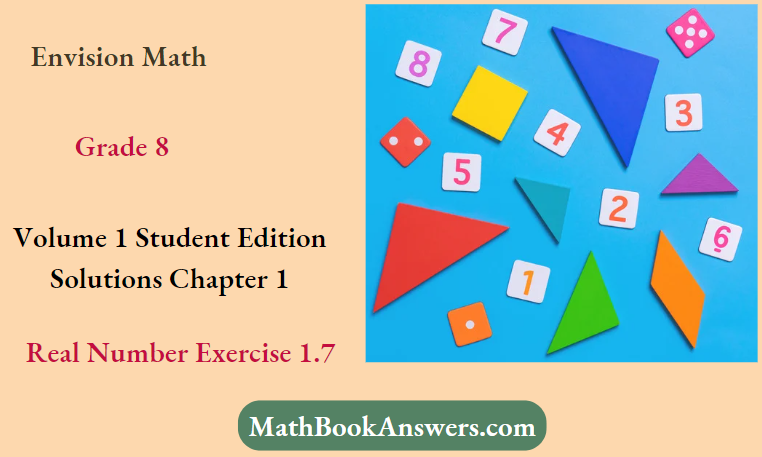
Page 45 Exercise 1 Answer
Given that, Calvin and Mike do sit-ups when they work out. They start with 64 sit-ups for the first set and do half as many for each subsequent set.
We need to explain how could we determine the number of sit-up sets Calvin and Mike do.
In the first set, the number of sit-ups they do is 64
In the next set, it will be 32 since it is half as many for each subsequent set.
For third set,16
We know that, 64=27
For each set, it is reduced as half.
The number of sit-ups is represented by the equivalent expression, 27−n
where n is the number of sets.
This expression is used to determine the number of sit-ups they do in each set.
The expression is used to determine the number of sit-ups they do in each set is 27−n
Envision Math Grade 8 Volume 1 Chapter 1 Exercise 1.7 Real Number Solutions
Page 46 Question 1 Answer
The zero exponent property states that when the exponent is zero while the base is non-zero, then the result will be one.
This means that, x0 = 1 where x ≠ 0
Example, 150 = 1
The negative exponent property states that when the exponent is negative, we need to put the number as a denominator in a fraction by changing the exponent into positive.
This means that, \(x^{-n}=\frac{1}{x^n}\) where x ≠ 0
Example, \(15^{-2}=\frac{1}{15^2}\)
The zero exponent property states that when the exponent is zero while the base is non-zero, then the result will be one.
The negative exponent property states that when the exponent is negative, we need to put the number as a denominator in a fraction by changing the exponent into positive.
Page 46 Exercise 1 Answer
We need to evaluate (−7)0
The zero exponent property states that when the exponent is zero while the base is non-zero, then the result will be one.
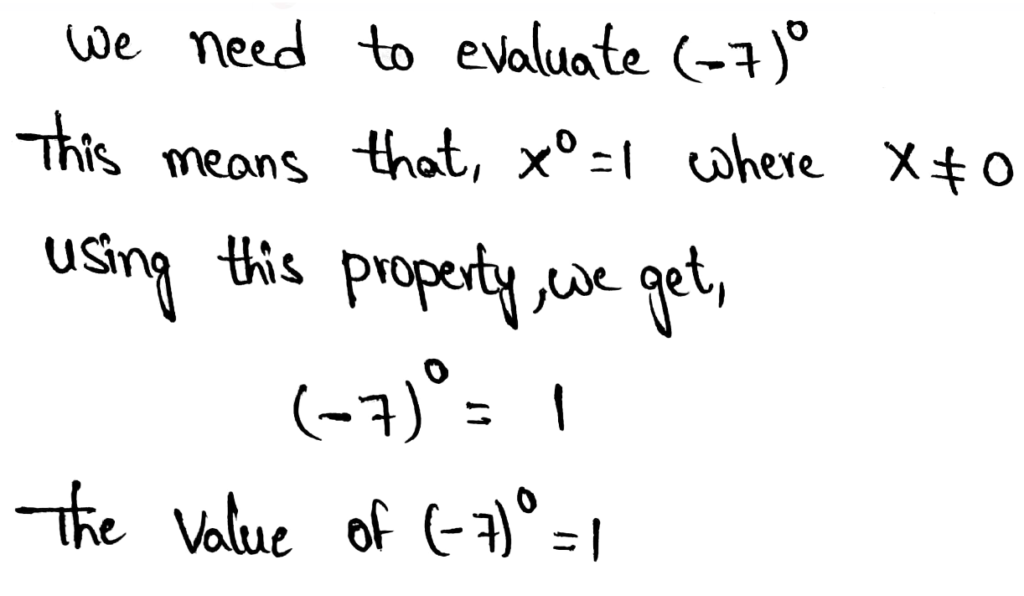
The value of (−7)0 = 1
We need to evaluate (43)0
The zero exponent property states that when the exponent is zero while the base is non-zero, then the result will be one.
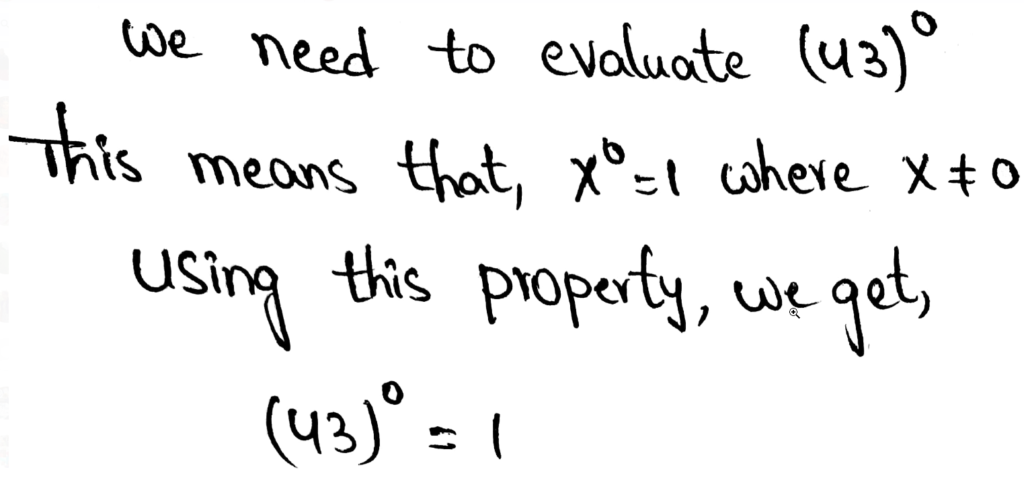
We need to evaluate 10
The zero exponent property states that when the exponent is zero while the base is non-zero, then the result will be one.

The value of 10 = 1
We need to evaluate (0.5)0
The zero exponent property states that when the exponent is zero while the base is non-zero, then the result will be one.

The value of (0.5)0 = 1
Envision Math Grade 8 Student Edition Exercise 1.7 Real Numbers Answers
Envision Math Grade 8 Volume 1 Student Edition Solutions Chapter 1 Real Number Exercise 1.7 Page 47 Exercise 3 Answer
We need to evaluate \(\frac{1}{5^{-3}}\)
The negative exponent property states that when the exponent is negative, we need to put the number as a denominator in a fraction by changing the exponent into positive.
This means that, \(x^{-n}=\frac{1}{x^n} \text { where } x \neq 0\)
The negative exponent property states that when the exponent is negative, we need to put the number as a denominator in a fraction by changing the exponent into positive.
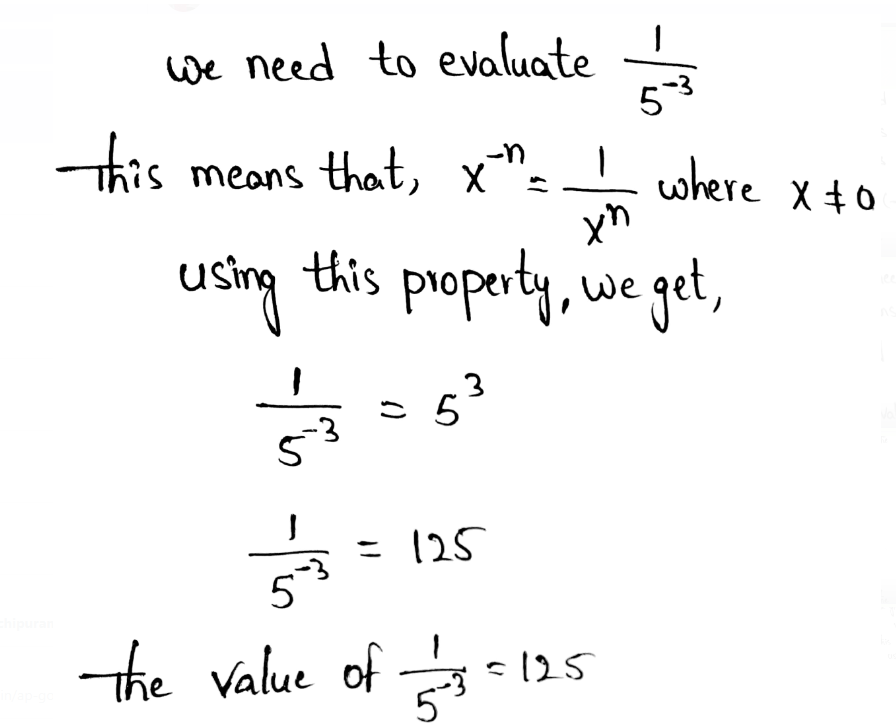
Page 46 Exercise 1 Answer
We need to evaluate why 2(70) = 2
The zero exponent property states that when the exponent is zero while the base is non-zero, then the result will be one.
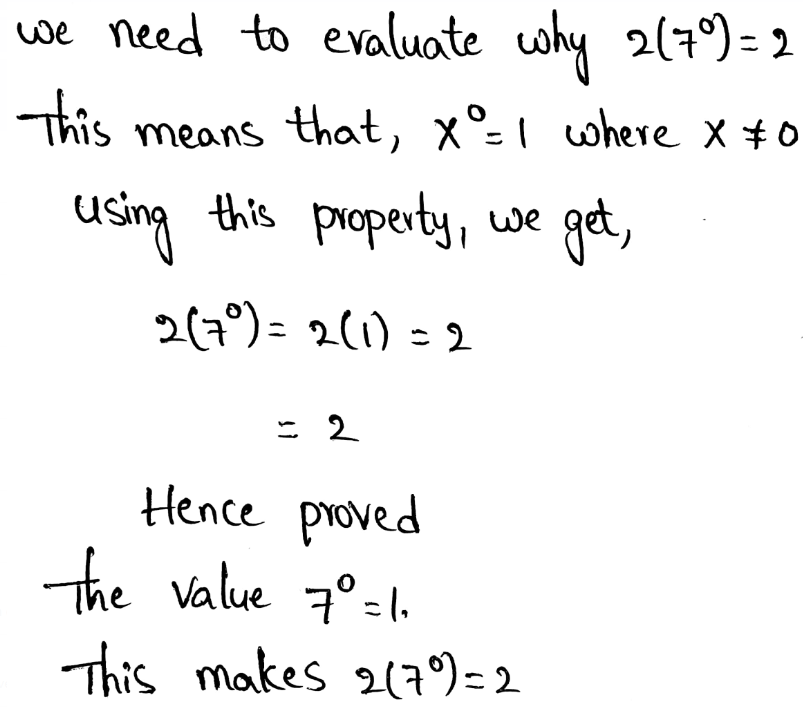
The value 70 = 1. This makes 2(70) = 2
Page 48 Exercise 1 Answer
The zero exponent property states that when the exponent is zero while the base is non-zero, then the result will be one.
This means that, x0 = 1 where x ≠ 0
Example, 170 = 1
The negative exponent property states that when the exponent is negative, we need to put the number as a denominator in a fraction by changing the exponent into positive.
This means that, \(x^{-n}=\frac{1}{x^n} \text { where } x \neq 0\)
Example, \(5^{-2}=\frac{1}{5^2}\)
The zero exponent property states that when the exponent is zero while the base is non-zero, then the result will be one.
The negative exponent property states that when the exponent is negative, we need to put the number as a denominator in a fraction by changing the exponent into positive.
Real Number Solutions Grade 8 Exercise 1.7 Envision Math
Envision Math Grade 8 Volume 1 Student Edition Solutions Chapter 1 Real Number Exercise 1.7 Page 48 Exercise 2 Answer
We need to describe what does the negative exponent mean in the expression 9−12
The negative exponent property states that when the exponent is negative, we need to put the number as a denominator in a fraction by changing the exponent into positive.
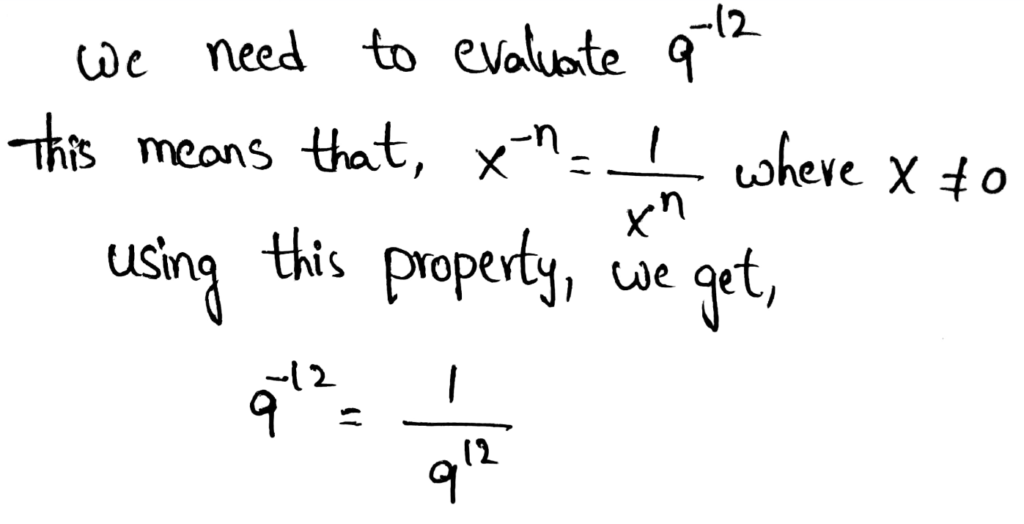
The negative exponent means that it can be written as a fraction with a positive exponent using the negative exponent property.
Page 48 Exercise 4 Answer
We need to simplify the expression 19999990
The zero exponent property states that when the exponent is zero while the base is non-zero, then the result will be one.

Page 48 Exercise 6 Answer
We need to find the value of 27x0y−2 when the value of x=4 and y=3
The given expression is 27x0y−2
Using the zero and negative exponents property, the expression will be,
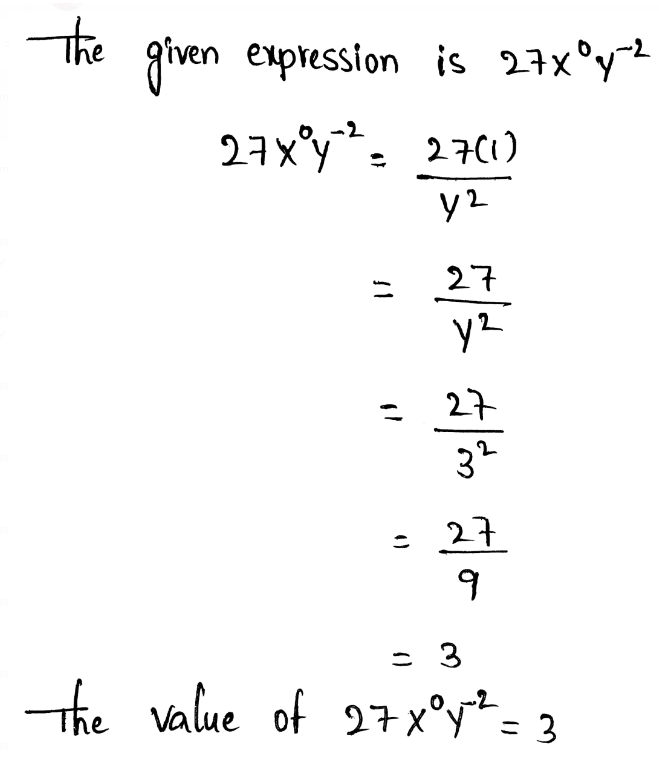
The value of 27x0y−2 = 3
Envision Math Grade 8 Volume 1 Student Edition Solutions Chapter 1 Real Number Exercise 1.7 Page 49 Exercise 7 Answer
We need to complete the given table to find the value of a nonzero number raised to the power of 0.
The given table is,

By evaluating and completing the given table, we get,
44 = 256
\(4^3=\frac{256}{4}=64\) \(4^2=\frac{64}{4}=16\) \(4^1=\frac{10}{4}=4\) \(4^0=\frac{4}{4}=1\)The completed table is,
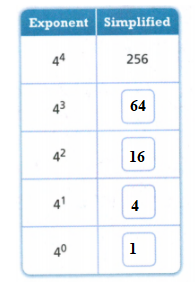
Envision Math 8th Grade Exercise 1.7 Step-By-Step Real Number Solutions
Page 49 Exercise 8 Answer
We need to complete the given table to find the value of a nonzero number raised to the power of 0.
The given table is,

By evaluating and completing the given table, we get,
(−2)4 = −2 × −2 × −2 × −2 = 16
(−2)3 = −2 × −2 × −2 = −8
(−2)2 = −2 × −2 = 4
(−2)1 = −2
(−2)0 = 1
The completed table is,
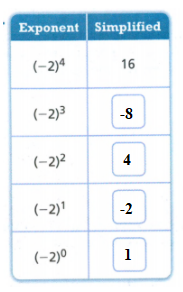
Envision Math Grade 8 Volume 1 Student Edition Solutions Chapter 1 Real Number Exercise 1.7 Page 49 Exercise 9 Answer
We need to simplify the given expression (−3.2)0
The zero exponent property states that when the exponent is zero while the base is non-zero, then the result will be one.
This means that, x0 = 1 where x ≠ 0
Using this property, we get,
(−3.2)0 = 1
The value of (−3.2)0 = 1
We need to write two expressions equivalent to the given expression (−3.2)0. Also, explain why the three expressions are equivalent.
The zero exponent property states that when the exponent is zero while the base is non-zero, then the result will be one.
Thus the value of the given expression is (−3.2)0 = 1
Therefore, the two expressions equivalent to the given expression is, 50 and (−15)0
This is because according to zero exponent property, anything to the power of 0 will result in the number one.
The two expressions equivalent to the given expression is 50 and (−15)0.
The three expressions are equivalent since according to zero exponent property, any number to the power of 0 will result in 1.
Part 49 Exercise 10 Answer
We need to simplify the expression 12x0(x−4) when the value of x = 6
The zero exponent property states that when the exponent is zero while the base is non-zero, then the result will be one.
The negative exponent property states that when the exponent is negative, we need to put the number as a denominator in a fraction by changing the exponent into positive.
Thus, using these properties, we get,
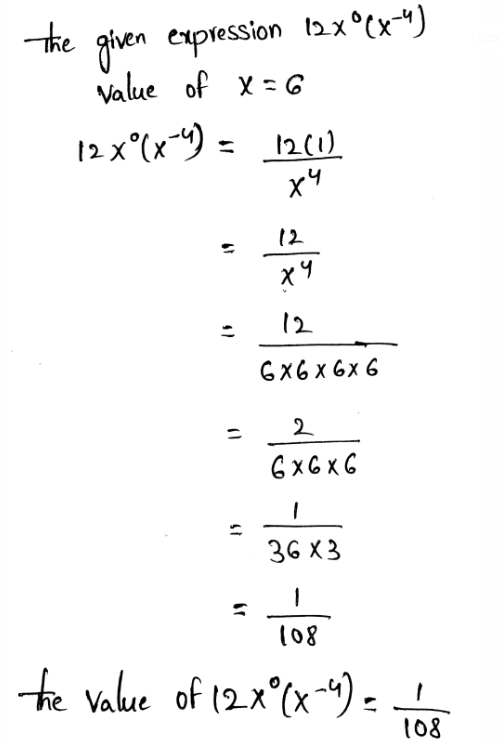
The value of \(12 x^0\left(x^{-4}\right)=\frac{1}{108}\)
We need to simplify the expression 14(x−2) when the value of x = 6
The negative exponent property states that when the exponent is negative, we need to put the number as a denominator in a fraction by changing the exponent into positive.
This means that, \(x^{-n}=\frac{1}{x^n} \text { where } x \neq 0\)
Using this property, we get,
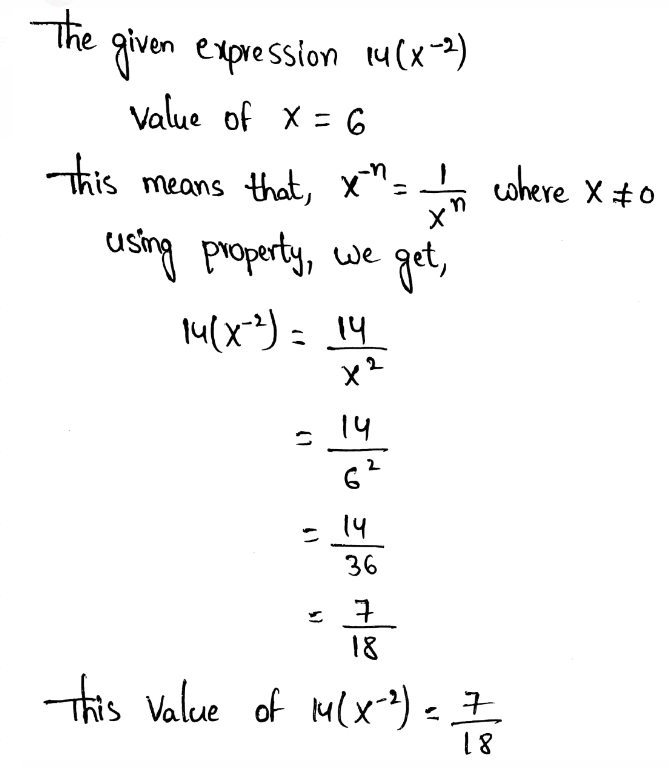
This value of \(14\left(x^{-2}\right)=\frac{7}{18}\)
Page 49 Exercise 12 Answer
We need to compare the values using <, > or =
The gives value is \(\left(\frac{1}{4}\right)^0 ? 1\)
The zero exponent property states that when the exponent is zero while the base is non-zero, then the result will be one.
Using this property, we get,
\(\left(\frac{1}{4}\right)^0=1\)Thus, the given value becomes, \(\left(\frac{1}{4}\right)^0=1\)
The given value becomes,\(\left(\frac{1}{4}\right)^0=1\)
How To Solve Exercise 1.7 Real Numbers In Envision Math Grade 8
Envision Math Grade 8 Volume 1 Student Edition Solutions Chapter 1 Real Number Exercise 1.7 Page 49 Exercise 13 Answer
We need to rewrite each expression using a positive exponent. The given expression is 9−4
The negative exponent property states that when the exponent is negative, we need to put the number as a denominator in a fraction by changing the exponent into positive.
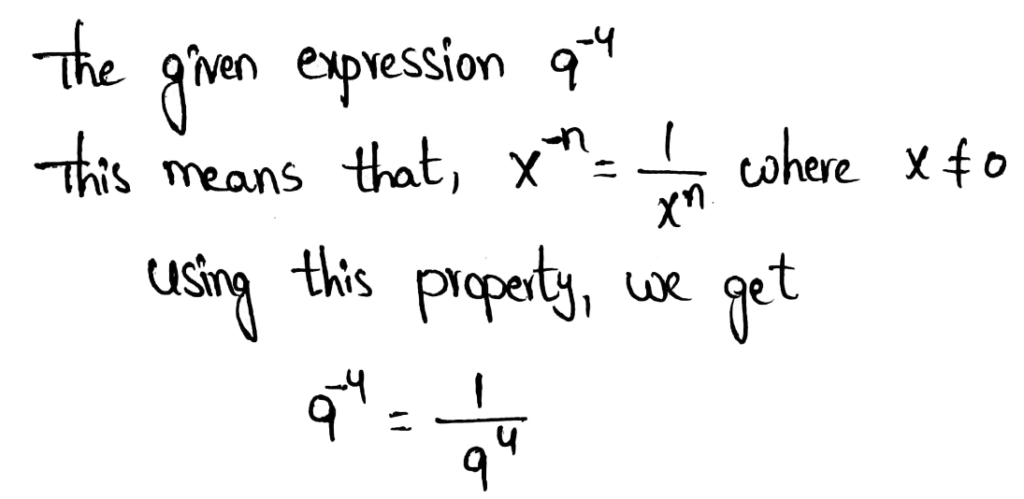
Rewriting the expression using a positive exponent, we get,\(9^{-4}=\frac{1}{9^4}\)
Page 49 Exercise 14 Answer
We need to rewrite each expression using a positive exponent.
The given expression is \(\frac{1}{2^{-6}}\)
The negative exponent property states that when the exponent is negative, we need to put the number as a denominator in a fraction by changing the exponent into positive.
This means that, \(x^{-n}=\frac{1}{x^n} \text { where } x \neq 0\)
Using this property, we get,
\(\frac{1}{2^{-6}}=2^6\)Rewriting the expression using a positive exponent, we get, \(\frac{1}{2^{-6}}=2^6\)
Page 49 Exercise 15 Answer
We need to evaluate 9y0 when y=3
The zero exponent property states that when the exponent is zero while the base is non-zero, then the result will be one.
This means that, x0 = 1 where x ≠ 0
Using this property, we get,
9y0 = 9(1)
= 9
The value of 9y0 = 9
Given: 9y0
We need to find whether the value of the given expression will vary depending on y
The zero exponent property states that when the exponent is zero while the base is non-zero, then the result will be one.
This means that, x0 = 1 where x ≠ 0
Using this property, we get,
9y0 = 9(1) = 9
The result obtained will not have any relation with the value of y
The value of the given expression does not vary depending on the value of y
Page 50 Exercise 16 Answer
We need to simplify the expression −5x−4 when x = 4
The negative exponent property states that when the exponent is negative, we need to put the number as a denominator in a fraction by changing the exponent into positive.
This means that, \(x^{-n}=\frac{1}{x^n} \text { where } x \neq 0\)
Using this property, we get,
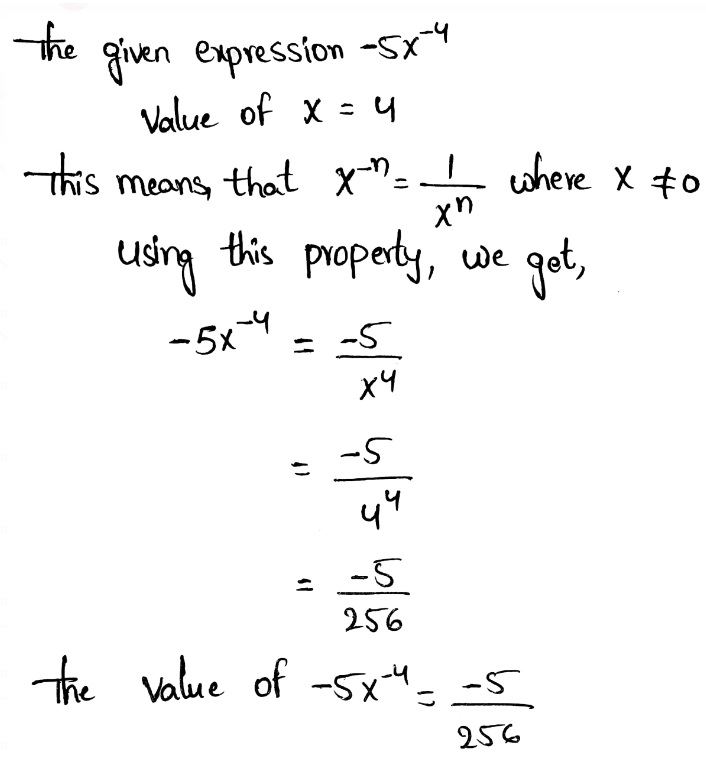
We need to simplify the expression 7x−3 when x=4
The negative exponent property states that when the exponent is negative, we need to put the number as a denominator in a fraction by changing the exponent into positive.
This means that, \(x^{-n}=\frac{1}{x^n} \text { where } x \neq 0\)
Using this property, we get,
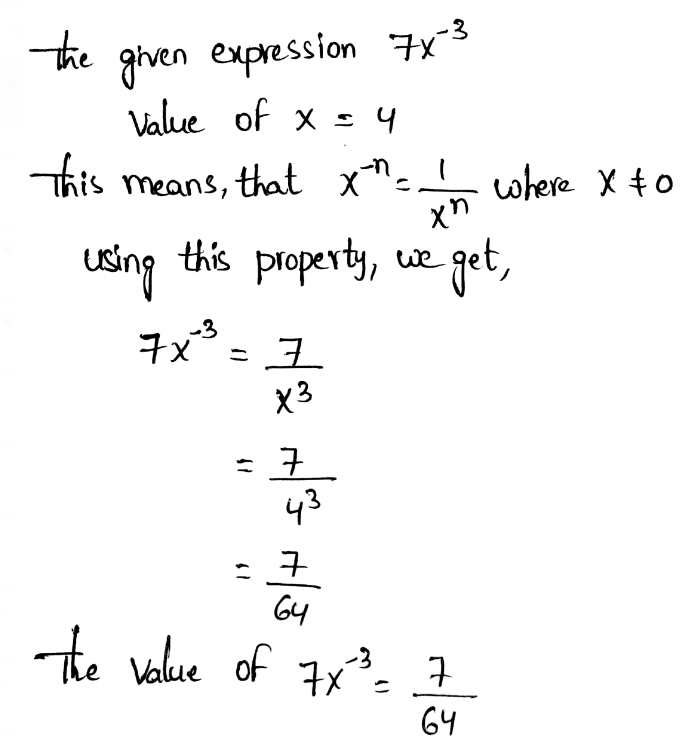
The value of \(7 x^{-3}=\frac{7}{64}\)
Envision Math Exercise 1.7 Real Numbers Detailed Answers
Envision Math Grade 8 Volume 1 Student Edition Solutions Chapter 1 Real Number Exercise 1.7 Page 50 Exercise 17 Answer
We need to evaluate the expression (−3)−8 and −3−8
The given expressions are (−3)−8 and −3−8
Evaluating using negative exponents property, we get,
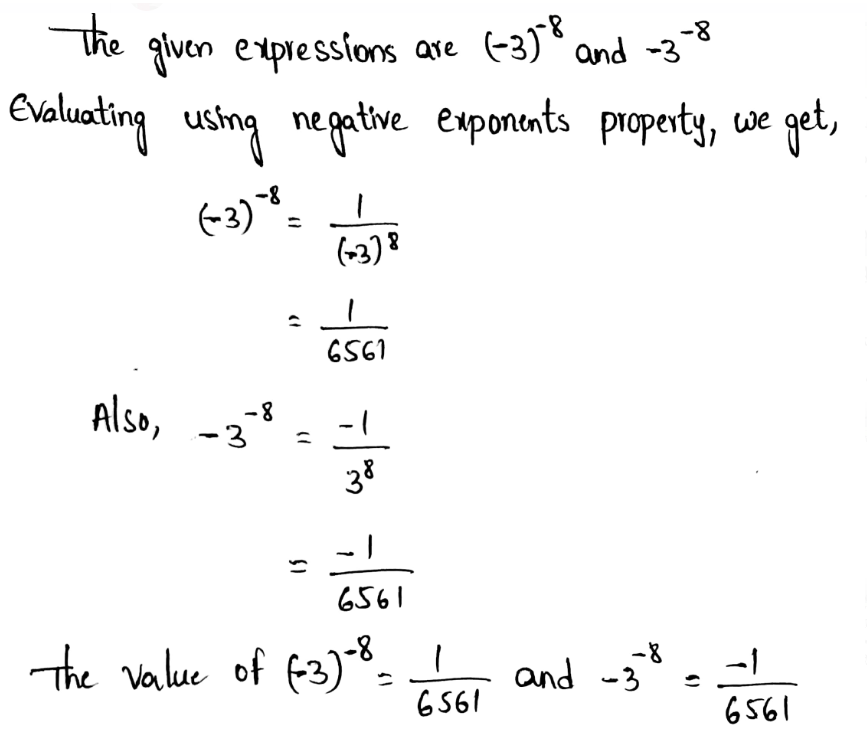
The value of \((-3)^{-8}=\frac{1}{6561} \text { and }-3^{-8}=\frac{-1}{6561}\)
We need to evaluate are (−3)−9 and −3−9
The given expressions are (−3)−9 and −3−9
Evaluating using negative exponents property, we get,
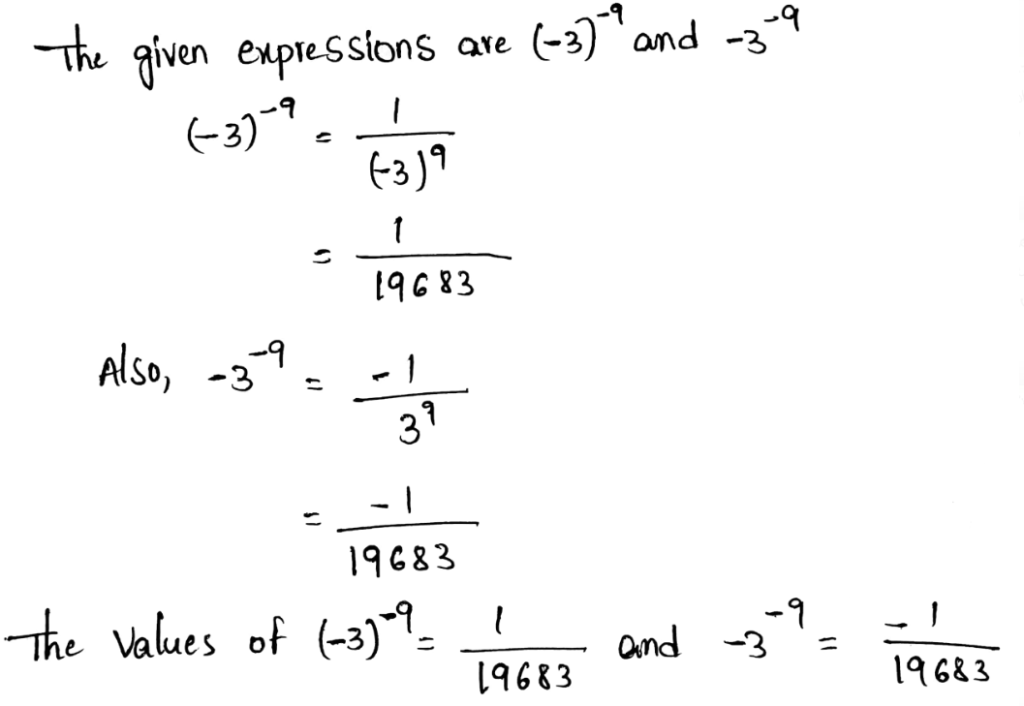
The values of \((-3)^{-9}=\frac{-1}{19683} \text { and }-3^{-9}=\frac{-1}{19683}\)
Page 50 Exercise 19 Answer
We have to simplify the expression. We need to assume that x is nonzero. Our answer should have only positive exponents.
The expression is x−10x6
The negative exponent property states that when the exponent is negative, we need to put the number as a denominator in a fraction by changing the exponent into positive.
Using this property, we get,
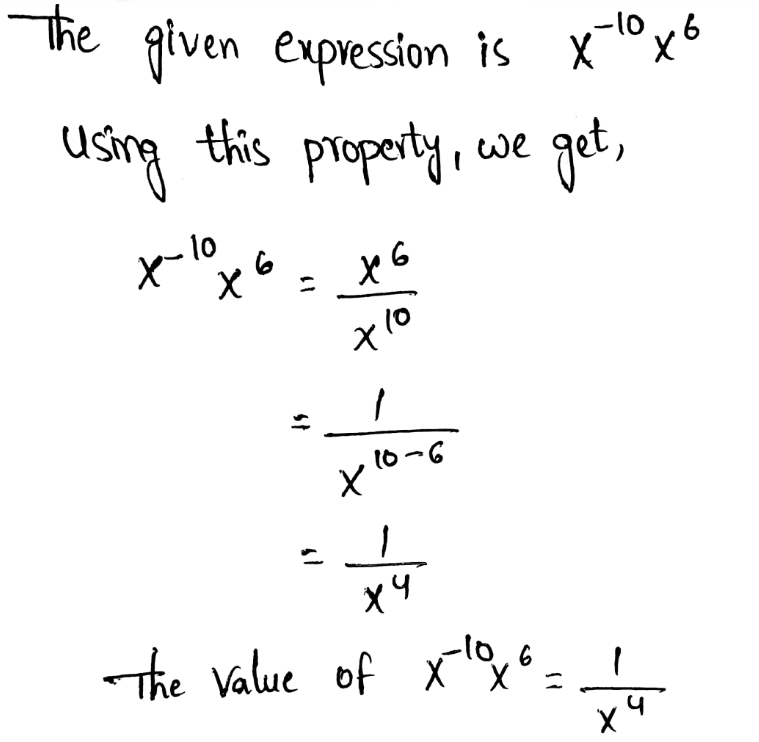
The value of \(x^{-10} x^6=\frac{1}{x^4}\)
Page 50 Exercise 20 Answer
We need to find whether the value of the expression \(\left(\frac{1}{4^{-3}}\right)^{-2}\) is greater than 1, equal to 1, or less than 1.
The negative exponent property states that when the exponent is negative, we need to put the number as a denominator in a fraction by changing the exponent into positive.
Using this property, we get,
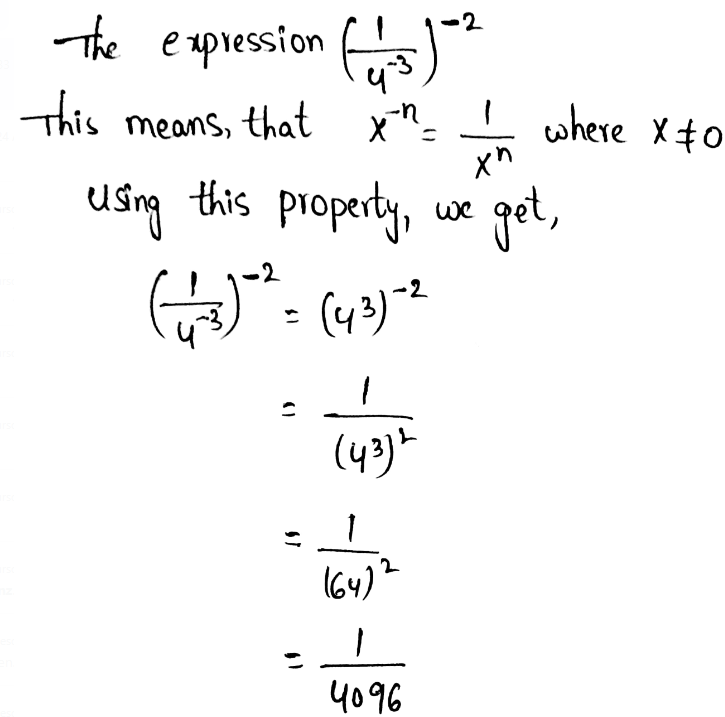
The value is less than 1.
The value of \(\left(\frac{1}{4^{-3}}\right)^{-2}=\frac{1}{4096}\) which is less than the number 1.
Given that, If the value of the expression is greater than 1, we need to show how you can change one sign to make the value less than 1. If the value is less than 1, we need to show how you can change one sign to make the value greater than 1 . If the value is equal to 1, we need to show how you can make one change to make the value not equal to 1.
The given expression is,\(\left(\frac{1}{4^{-3}}\right)^{-2}\)
It will be equal to the value \(\left(\frac{1}{4^{-3}}\right)^{-2}=\frac{1}{4096}\)
The value is less than the number 1.
In order to make the value greater than 1, change one of the signs of the expression as follows,
\(\left(\frac{1}{4^{-3}}\right)^2=\left(4^3\right)^2=64^2=4096\)In this way, we can make it greater than one.
The sign was changed from \(\left(\frac{1}{4^{-3}}\right)^{-2} \text { to }\left(\frac{1}{4^{-3}}\right)^2\) to make it greater than one.
Envision Math Grade 8 Exercise 1.7 Practice Problems
Envision Math Grade 8 Volume 1 Student Edition Solutions Chapter 1 Real Number Exercise 1.7 Page 50 Exercise 22 Answer
We need to find which expressions have values less than 1 when x = 4 from the given expressions.
The negative exponent property states that when the exponent is negative, we need to put the number as a denominator in a fraction by changing the exponent into positive.
The zero exponent property states that when the exponent is zero while the base is non-zero, then the result will be one.
Using these properties, solving the given, we get,
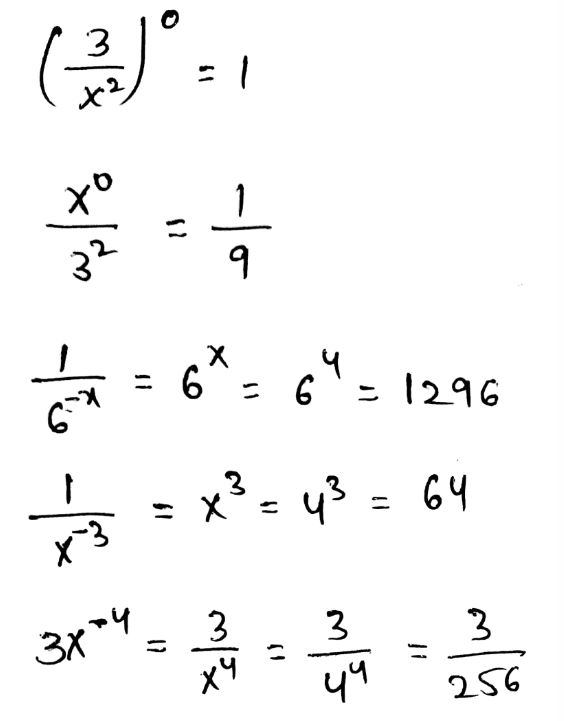
The values which are less than 1 are,
\(\frac{x^0}{3^2}\) \(3 x^{-4}\)